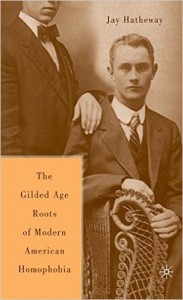 The Gilded Age Construction of Modern American Homophobia
The Gilded Age Construction of Modern American Homophobia
by Jay Hatheway
Palgrave Macmillan
232 pages, $45.
Jay Hatheway’s The Gilded Age Construction of Modern American Homophobia traces the progression from the “invention” of the homosexual to the “construction” of a new kind of beast that threatens the very foundation of the civilized world. Hatheway is at home in the old essentialist-constructionist debate that permeates gay and lesbian studies; but to his credit he has dug beneath the historical moment in 1869 when the word “homosexual” was first coined. Prior to that time, going back at least to the Enlightenment in the 17th and 18th centuries, same-sex affection remained largely unspoken and undefined, existing as a habit or hobby to place alongside nail biting or fox hunting.
Hatheway argues that the United States was founded on an ideological trinity: essentialism, exceptionalism, and Puritanism. Exceptionalism reveled in the U.S. as a grand social experiment that was unburdened by the Old World’s corruption. Essentialism stated that men and women were by nature meant to marry and to reproduce, while any deviation from that model was unnatural and uncivilized. Puritanism decried sensual pleasures without reproductive intent. Its strains run deep in the American tradition, buttressing the essentialist dread of sodomy. According to Hatheway, the vaunted “freedom” as defined by the Founding Fathers has been misinterpreted. It “did not mean license, but rather the ability to live in conformity to the Laws of Nature. … Freedom was, therefore, a fundamentally conservative principle.” No wonder homosexuality has had a long dormancy in American society. The obstacles are everywhere.
The 19th-century pivot point was Darwinism, which enabled America’s style of homophobia to run amok. Darwin’s evolutionary theory encouraged people to see the world not as being, but as becoming. A pre-Darwin world model might stress the natural, static order of birth, maturity, reproduction, and death. There was no explanation for homosexuality, and none was thought to be needed. But once Darwinism was applied to society, the newly minted homosexual violated natural law, since he didn’t reproduce and didn’t participate in evolution.
Social Darwinism (which Darwin himself repudiated) combined with American exceptionalism to view America as standing at the pinnacle of human achievement. How, then, to explain the growing plague of deviants engaging in unnatural sexual acts? Social Darwinists saw the worst vice in cities, where the homosexuals congregated to form underground societies. American cities were exploding during the Gilded Age (roughly 1870 to 1900) due to new immigration and industrialization. Social Darwinists saw the homosexual as one of the costs of progress, advancing technology, and rapid social change. This also explained why most homosexuals were white, well-educated, and urban. The superior race was destined to suffer disproportionately from diseases of nervous stress such as homosexuality.
Hatheway focuses his historical research almost entirely on medicine, to the neglect of government and religion. While industrialization and urbanization continued unchecked, American medicine remained behind the times, underfunded and unprotected against quackery. Vanguard medical professionals knew that Europe was the source of the day’s breakthroughs. It was the Austro-Hungarian writer Karl Maria Kertbeny who invented the word “homosexual” in 1869, but it was Viennese neurologist Richard von Krafft-Ebing who saw to it that this abnormality be studied under the light of science. He saw congenital homosexuality as a hereditary corruption of the sex drive, but he also showed latent compassion for those afflicted. He noted with some chagrin that most of his patients appeared to be otherwise well-adjusted, functioning adults. He wrote that they were “unhappy only in so far as social and legal barriers stand in the way of the satisfaction of their instinct toward their own sex.”
The peculiar mix of Gilded Age social science, blind assumptions, and misguided public welfare brought about atrocities that live into the present day. Hatheway doesn’t offer a single quote from Michel Foucault, though he echoes the sentiment in Foucault’s famous comment from The History of Sexuality that “the sodomite had been a temporary aberration; the homosexual was now a species.” And what a blighted, deranged species it was! Homosexuality came to be associated with masturbation, an act so vile that it had reputable medical doctors proclaiming that it “impairs the intellectual and moral faculties, and debases the mind in the highest degree.” One published case avows that masturbation caused a 21-year-old man’s insanity, his effeminacy, and his “morbid attachments for persons of his sex.” In the most dire cases, the cure was castration or hysterectomy.
Hatheway gives scant attention to those voices of the time that sound enlightened to the modern ear. The name of his book, after all, promises an examination of what went wrong, not what went right. He does make room for Magnus Hirschfeld, the gay Jewish-German doctor who fought hard for the legal emancipation of homosexuals. Edward Carpenter, John Addington Symonds, and Walt Whitman, among others, are also offered here as progressives for their time.
The Gilded Age Construction of Modern American Homophobia invites comparisons between then and now. Hatheway notes that marriage was to be offered “only to those who showed no ‘signs’ of mental or moral deficiency, for it was a well-known ‘fact’ that inappropriate marriages were ‘the fountainhead of the stream of degeneracy that sweeps through all social systems.’” Then, as now, there was confusion between homosexuality and transvestitism, and it was assumed that gender confusion went hand-in-glove with a same-sex sexual orientation.
Hatheway’s book is appealingly compact, but cursed with a scandalously small type size. With a $45 price tag, one might expect photographs of a few of the books major figures, but its 232 pages is solid text. Cost and design qualms aside, this is an astute and valuable contribution to the sociological history of sex in America.
Matthew Kennedy teaches anthropology at the City College of San Francisco and is the author of Edmund Goulding’s Dark Victory: Hollywood’s Genius Bad Boy (University of Wisconsin Press, 2004).





